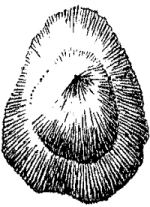 Synonyms: Patella
caerulea var. tenuistriata Weink.-Ostroumoff, 1893; P.caerulea
L.-Kobelt,1898; P.pontica Mil.-Milashevich 1914,1916; P.caerulea
pontica Mil.-Ilina,1966).
Synonyms: Patella
caerulea var. tenuistriata Weink.-Ostroumoff, 1893; P.caerulea
L.-Kobelt,1898; P.pontica Mil.-Milashevich 1914,1916; P.caerulea
pontica Mil.-Ilina,1966).Patella tarentina (Salis, 1793)
 Synonyms: Patella
caerulea var. tenuistriata Weink.-Ostroumoff, 1893; P.caerulea
L.-Kobelt,1898; P.pontica Mil.-Milashevich 1914,1916; P.caerulea
pontica Mil.-Ilina,1966).
Synonyms: Patella
caerulea var. tenuistriata Weink.-Ostroumoff, 1893; P.caerulea
L.-Kobelt,1898; P.pontica Mil.-Milashevich 1914,1916; P.caerulea
pontica Mil.-Ilina,1966).
Common names: Engl: Limpet; Bulg: Kitayska shapitsa; Russ: Blyudechko; Turk: Cin sapkasi; Ukr: Blyudechko.
Order (Scientific): DOCOGLOSSA.
Family (Scientific): PATELLIDAE.
Taxonomic descriptions: A sea snail with a shell resembling a Chinese cap where the Bulgarian name originates from. The shape of the shell is oval almost circular with the upper part slightly shifted to the front end, which is noticeably narrower than the back end. The shell is sculptured with dense radial ribs, unequally high and dense and very thin concentric growth circles. The edge of the shell is finely indented. The color is yellow - white with red - brown rays. The length of the shell is up to 45 mm, its breadth - up to 30 mm, its height - up to 14 mm.
 IUCN Status:
IUCN Status:
World level:
Black Sea Regional level: EN
Subregion level: EN (Ukrainian sector)
Distribution: Black Sea, The Sea of Azov, Mediterranean Sea.
Habitat type. Critical habitats. Limiting factors: A typical contourobiont, inhabiting the rocky coast mediolittoral zone, except low salinity waters and areas which can be covered with ice in winter if only for a few hours. The main limiting factor is the pollution of coastal waters, especially by toxic surfactants, including oil.
Biology: Limpets are vegetarians, browsing on algae films on the rocky surface. Their pelagic larvae are of trochophore type. In some Black Sea coasts limpets are considered edible, after light boiling in sea water.
Population trends: Visible decline in population numbers since the early 1980s. A reduction of at least 70% over the last 10 years, based on direct observations.
Threats: Pollution of coastal waters by toxic surfactants.
Conservation measures taken: None.
Conservation measures proposed: Entry in the Black Sea Red Data Book. Reduction in the pollution of the Black Sea coastal zone.
References:
Compiled by: T.Konsulova, Yu.Zaitsev.